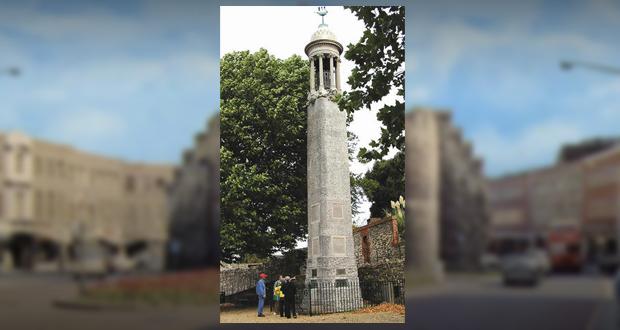
By Cecil Scaglione
Southampton, England— In a quiet stand of trees outside the old city’s western wall is atestimonial to the heart and hardiness of America.
The Mayflower Memorial overlooks the site where last-minute repairs were made to a creaking wine ship before its two-month voyage from England to New England in the fall of1620.
Since then, this waterfront community has been the last port of call for millions of emigres to the United States, Canada, Australia, New Zealand, South Africa and other parts of the world.
The Mayflower saga is memorialized by an unassuming limestone tower that supports a copper replica of the ship that eventually set sail with 104 Pilgrims and 30 crewmen to plant a colony that would grow into the most powerful democracy on the globe.
Anybody who can trace their ancestry back to those original dissidents can have their name added to the plaque on the tower.
This bustling port of a quarter of a million people that has played a major role in much of British and U.S. history doesn’t appear on many travelers’ radar despite being within an hour from the
much-visited Stonehenge and its 5,000-year-old monoliths hunkered into the Salisbury Plain.
It’s a leisurely train ride from Gatwick Airport midway between London and Brighton. The trackstrundle through suburbanized southern England sprinkled with glimpses of cattle and castles, horses and hothouses, and sheep, small towns, and school soccer practices.
Students from the research-driven University of Southampton and other local campuses give the city an up-to-the-minute air as you wander through and around its historic sights.

saga of the ship that set sail for America in 1620 with 104 Pilgrims and 30 crewmen. A copper
replica of the vessel is perched atop the tower.
photo: Cecil Scaglione
Occupying a prominent position in downtown’s East Park is a tribute to those Southampton men who helped build the Titanic, which set sail from here on its disastrous 1912 maiden voyage, and stayed with her to the bottom.
One of the many memorials to this legendry liner is a large stone pedestal crowned by a bronze angel with wings outstretched as it stands on the prow of a ship, reminiscent of a scene made famous by actress Kate Winslet in the 1997 Hollywood epic centered around the celebrated ship.
The new city has been built around Old Town, which stretches south from the main business and shopping district.
Entry is through Bargate, Southampton’s most recognizable landmark, that was the city’s main entrance for much of its history that became busy shortly after the Norman victory at the Battle of
Hastings in 1066.
Begun in the 12th century and completed in the 15th, the gate. which was built just wide enough for a horse-drawn coach to squeeze through, was not only a means of defense but also a symbol of political power.
Flanked by two lead lions said to protect the city, the gate was once the site of town council meetings, the local court, and toll-road collections. Shields mounted over the entrance represent
prominent families that governed Southampton. A life-sized statue of George III, the “Mad George” who “lost” the American colonies, stands over the interior of the entry way.
A stone memorial just inside the gate bears a plaque recalling the havoc hurled here by German aircraft during World War Two. Southampton was blitzed badly because it housed a Spitfire factory besides being a major seaport that eventually was the debarkation point for more than 3 million Allied troops during the invasion of Hitler-held Europe.
Another reminder of how military and maritime matters mingle is the skeletal remains of Holyrood Church, where Crusaders worshiped on their way to the Holy Land. It was almost destroyed by enemy bombers in1940 and serves as a memorial to Southampton sailors who lost there lives at sea.
There’s a Walk the Walls tour that’s free and takes you over the roofs of sturdy merchant’s homes that formed the defensive barricade after a 14th-century French raid. It not only pulls visitors
through history, it also offers them alluring panoramic views of the waterfront and draws them tothe weekly market erected around the Bargate.
Before leaving Old Town, we stopped at the Duke of Wellington, an Elizabethan-looking pub just inside the Westgate on the old walls, to sample fish and chips. A few years earlier, a guide at the Buckingham Palace stables in London advised us to sample this British staple in seaside towns because the fish is fresher.
The dish served here proved her advice was sound.
About Cecil Scaglione: Cecil is a former San Diego Union-Tribune writer and for a number of years has been a world traveler, writer and currently a syndicated columnist.



